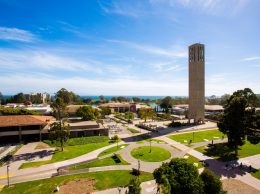Isla Vista tragedy shows the dark side of paradise
IN THIS ARTICLE
- South Coast Topic
- Erika Martin Author
By Erika Martin Friday, May 30th, 2014

About 4,000 people showed up to remember the victims of Friday night’s bloody massacre in Isla Vista. (Erika Martin / Business Times photos)
To the outside world, Isla Vista looks like a college-town paradise.
Sun-kissed students glide beneath the palm trees on bicycles and skateboards, taking in stunning beach cliff views along the way to class at nearby UC Santa Barbara. Restaurants with cheap eats dot the main thoroughfare, and beer is never too difficult to come by.
But inside Isla Vista, there is a darker side.
With 23,000 people crammed into less than a square mile of rundown apartments where landlords reap a premium for barely habitable units, the student neighborhood contains 7 percent of Santa Barbara County’s population but accounts for 25 percent of its serious crime. This year alone, the densely packed community has been rocked by two high-profile gang rapes, drunken riots quelled with tear gas and, on May 23, a bloody killing rampage that left six innocent people and suspect Elliot Rodger dead, along with 13 seriously injured.
Lost in the media blitz over the Memorial Day weekend violence is the fact that Isla Vista remains an unincorporated territory within Santa Barbara County that has never had effective local government or been integrated into UCSB or the larger Santa Barbara region.
The status of Isla Vista stands in stark contrast to how other universities, such as Cal Poly San Luis Obispo, handle the relationship between campus, students and community.
The May 23 killings by a former Santa Barbara City College student with no direct ties to UCSB have ignited new questions about whether the blame for Isla Vista’s rising crime lies with the decades-long view of the student community as a necessary evil and the failure of the South Coast to govern its residents as members of the broader community.
Unincorporated territory
In the wake of the massacre last weekend, several business and community leaders reached by the Business Times suggested the need for better oversight of Isla Vista. One of them was Congresswoman Lois Capps, D-Santa Barbara, whose late husband was on the UCSB faculty before being elected to Congress.
“This tragedy calls for us to examine Isla Vista,” she wrote in an email to the Business Times. “My top priority is the safety and well-being of the students and residents of Isla Vista, and the public safety personnel trying to keep them safe.” She added that she hopes to convene a meeting of key stakeholders including university officials, students, law enforcement and others to examine “what changes can be explored.”
Isla Vista has a population of 23,096, with transients and low-income residents, as well as a few remaining homeowners, living alongside the student population. As an unincorporated area, 27 different county agencies provide services to the residents and businesses of Isla Vista.
In a series of reports produced in the early 2000s, the Santa Barbara County Grand Jury determined that “the multitude of problems” in the community could be traced back to the fact that “no agency has been charged with responsibility to correct the problems that have been identified and studied for years.”
The Isla Vista Redevelopment Agency was laid to rest, along with the rest of the California’s redevelopment agencies, in 2012. When the city of Goleta incorporated in 2002, the leaders of the movement took pains to exclude Isla Vista.
As a result, Isla Vista remains politically isolated and orphaned from municipal governance.
Registered voters are represented by 3rd District Supervisor Doreen Farr. She also represents large swaths of the Santa Ynez Valley, an idyllic tourist destination dotted with dude ranches, vineyards and wineries. The landowners of the valley often have divergent interests from the renters of Isla Vista, which is one of the most densely packed square miles in the United States outside of San Francisco or New York.
The only entity under local control is the Isla Vista Recreation and Park District, to which voters elect five board members.
The issue of governance over the area first arose with the civil unrest that broke out in the late 1960s and early ’70s. The riots culminated in the burning down of a Bank of America branch in 1970. Subsequent studies criticized the university and government response to the demonstrations. UCSB’s enrollment dropped in the fall of 1970.
But fast-forward four decades and the governance issues remain. When the annual Deltopia street party threatened to bring an influx of outsiders to Isla Vista, the university paid for surveillance cameras along Del Playa Drive. Yet this year’s festivities quickly morphed into a destructive and violent street riot that had to be quelled with tear gas.
“The place is a mess here,” said Josh Plotke, a fifth-year UCSB student and Isla Vista resident. “When Goleta was incorporated, they left all the residential space to us, but we all shop in Goleta. Commercial space is a money-maker; residential space loses money. They carved out all the money-making parts and left us with the bill.”
Plotke supports establishing a community services district, an independent local government used to provide services in unincorporated areas of a county. Such districts are in place around the Tri-Counties, from Los Osos in San Luis Obispo County to Silverstrand beach in Ventura County.
Past efforts
Isla Vista has tried and failed to gain better government representation in the past.
In the early 1970s, state officials created municipal advisory councils to deal with race riots and civil unrest in urban settings. The quasi-representative bodies were intended to involve unincorporated communities in policy decisions to provide standard municipal services in areas distant from seats of local government. Santa Barbara was among the first counties in the state the use them.
UCSB Dean of Students Yonie Harris, who was an Isla Vista resident for 25 years and served on its advisory council, said although the body lacked the ability to tax and could only propose resolutions to the county government, it served as an important space that gave the community a voice.
“There could be some dialogue about what was going on. A citizen could come forward and say, ‘This happened to me,’ ” Harris said. “It was a place where community issues — which the Board of Supervisors can’t really look at in depth — were aired, discussed, and there could be some formulations brought out of this discussion.”
The Isla Vista Municipal Advisory Council held its first election in early 1971 with nine local residents of the student community elected to the government with funding from the county for operations. The county formed the park district that same year. The advisory council tried to incorporate Isla Vista in 1973, 1975 and again in 1985, but none of those efforts succeeded. The community has been orphaned ever since.
“I think over time, there was a sense of fatigue that set in. The park district picked up speed though, and it is a taxing body, it is like a services district, so it became the local government here for limited purposes,” Harris said. “But it’s never been a place where a broad spectrum of issues could be discussed. Do we really know what’s lacking here, what residents feel they need?”
A different approach
Roughly 98 miles north in San Luis Obispo, Cal Poly has a very different relationship with the surrounding community.
With the exception of a few large apartment complexes and sorority and fraternity houses right next to campus, students are spread out throughout the town, often living in rental houses neighboring San Luis Obispo families.
Cal Poly President Jeffrey Armstrong, who took the helm in 2011, has laid out a vision to build thousands of new on-campus housing units over the next decade. By 2022, the university, which like UCSB is known for strong science and engineering programs, hopes to have more than half of the its 20,000 or so students living on the campus.
Closely monitored campus housing is better for the students, Armstrong said in a keynote address on campus earlier this month, citing studies that show students who live in university housing tend to graduate sooner, have higher grades and be more engaged in extracurricular activities.
It also makes Cal Poly a better neighbor. “We’ve had great discussions with neighbors and city leaders that more students on campus is a good thing for the city of San Luis Obispo,” Armstrong said.
Cal Poly hasn’t always had such a frictionless existence in SLO. In 2004, annual Mardi Gras partying boiled over into a street riot that resulted in violent clashes with police. The following year, business and city leaders worked with law enforcement to quell the celebrations before they even got underway.
Over the last three years, Cal Poly has also taken an increasingly interventionist approach with its students’ off-campus lives.
In early 2013, the university began tracking student run-ins with law enforcement in San Luis Obispo, said Keith Humphrey, the university’s vice president for student affairs. “We go over the police logs every night,” he said, and Cal Poly students who have been arrested or cited also face disciplinary action from the university.
Humphrey said Cal Poly is focused on bringing more students into on-campus residences while at the same time encouraging them to be better connected with the community in surrounding San Luis Obispo.
“That’s tremendously important. That’s one of the main reasons we’re getting involved so much with students’ lives off-campus,” he said. “It’s an important chance for us to help students make the bigger-picture connections between their relationship with the larger world around them.”
Packed in population
Population density in Isla Vista rivals that of Boston, with students often paying big premiums to share rooms. Commercial real estate groups estimate that overall apartment vacancies on the South Coast are less than 1 percent, and in Isla Vista, it’s even lower.
The confluence of prevailing slow-growth sentiment on the South Coast, and the fear of Isla Vista becoming even denser and rowdier, has resulted in a deadlocked housing market. As a result, landlords can charge monthly rents of more than $1,000 for a single room in aging apartment complexes.
And yet the experience of living just blocks from the beach and within minutes of campus has its allure. Harris said the community is losing out on the potential to harness the human capital in Isla Vista.
“It’s a small, compact community like you never see. That’s why alumni always talk about how much they loved living there,” Harris said. “But it’s got some dark spaces too, and those are the things I think we need to work on as a community. I think everybody here has been changed by these events, and we could change the community too.”
— Staff writer Marlize van Romburgh contributed reporting.










